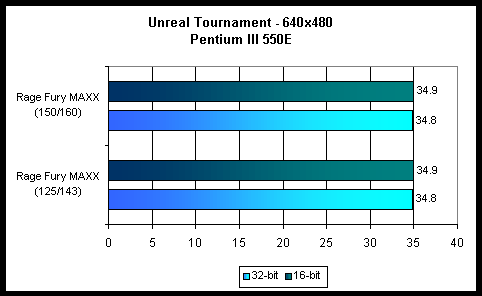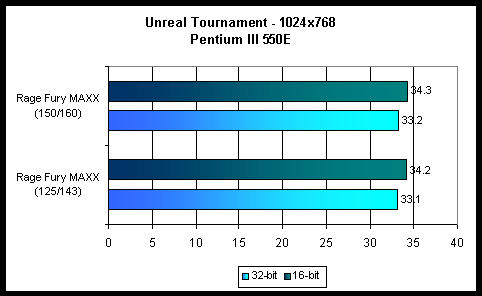Overclocking
One of the biggest lingering questions with the MAXX is "what happens when you overclock it?" More importantly, we had to find out if it could be overclocked at all since it's a very unique configuration. The Rage 128 Tweaker was unsuccessful in such endeavors and simply locked up. However, when in doubt, just go with Entech's Powerstrip, which came to the rescue once again. We used version 3.6, the latest at the time of this review, which detected the MAXX as just a regular Rage 128 Pro. Regardless, the method Powerstrip uses of going direct to hardware seems to have worked on the MAXX.
Overclocking the MAXX is a somewhat more sensitive quest compared to overclocking traditional, single chip cards. You now have two chips that must reach the desired speed, rather than just one. Further, and possibly more important, since the two chips are working in tandem, slight errors from one chip could adversely affect the other.
Nevertheless, we pushed ahead to see how far our retail Rage Fury MAXX sample would go. Thanks to the fairly cool running 0.25 micron Rage 128 Pro core, which is also covered by a quality heatsink and fan, we were able to push the core to 150 MHz without breaking a sweat. The Samsung 7ns/143 MHz SDRAM could only hit 160 MHz, typical of such memory from past experience.
The performance increase from overclocking the MAXX should be significant since the theoretical fill rate is calculated by multiplying the core clock speed by the four pixel pipelines. This means that an increase of the core clock speed by 5MHz results in a 20M pixel/s increase in peak fill rate. That means our MAXX running at 150/160 has a theoretical fillrate of 600 Megapixels/s and 5.1GB/s of memory bandwidth. Very impressive power, but how much would it affect real world performance? Let's take a look:


Under Quake3 Arena, the performance increase is noticeable and beneficial at 1024x768 where the MAXX is more fill rate bound. The effect is less pronounced than it could be due to the limited overclocking of the memory that we were able to accomplish. At 640x480, we see no increase in performance since everything is CPU and driver limited at such a low resolution.


In Unreal Tournament, however, the situation is quite different. Overclocking the MAXX had virtually no affect on performance, regardless of running at 640x480 or 1024x768. This is related to the Unreal Tournament engine more than anything else as we've seen similar results with other cards.










0 Comments
View All Comments